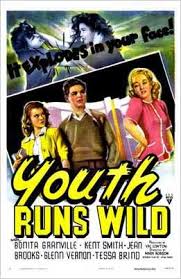
YOUTH RUNS WILD
US, 1944, 67 minutes, Black and white.
Bonita Granville, Kent Smith, Jean Brooks, Glenn Vernon, Vanessa Brown, Arthur Shields, Lawrence Tierney, Dickie Moore.
Directed by Mark Robson.
Youth Runs Wild was intended as a salutary film during World War II. While there was an emphasis on propaganda for the war effort in so many films, this is a rather roundabout war effort film, commenting on the possibilities for young people to run wild, not have aims, not contribute to the war effort.
The film seems particularly dated now. And comparisons could be made with youth running wild 10 years later in the archetypal youths film, Rebel Without a Cause. The behaviour of the young people here seems comparatively mild.
The film shows an ordinary American city, the older generation working in a munitions factory, working in shifts which disrupts family life.
The young boy at the centre of the film has been playing truant, is not interested in going to school, wants to make some money to buy a birthday gift for the girl next door, gets mixed up with the a robbery attempt at a parking yard, there are shots, and the boys in the car are picked up by the police for speeding. The boys are placed by a quite benevolent judge in the care of the boy’s brother-in-law, a veteran who has been wounded and has come back home to be with his wife and daughter.
The girl next door is a good girl but her parents are slack, the father drinking and ordering her around. She has a sense of responsibility for two young sisters. But she is attracted by the boy next door, and becomes involved with the shady garage owner who is responsible for the robberies, and his girlfriend who is on parole. When the boy is forbidden by his family to have anything to do with the girl, she is upset, is asked by her girlfriend to visit the garage owner in hospital and finishes up going to stay with the girl and acting as a hostess at the club.
All works out well eventually, the returning soldier perceiving some of the reality for the young man, talking to the girl and persuading her to come home, while he and his wife, who is presented as unduly critical of the newcomers to the street, looking down on them as riffraff, set up a playground-nursery in the yard for the young children in the street.
The film is based on magazine articles, showing some concern about the younger generation and what the war was meaning to them as well as parents’ strictness, or lack of strictness, and the consequences for the children.
The cast is lesser-known with Bonita Granville acting as the young woman on parole, tough exterior… Kent Smith is a sympathetic veteran of the war. Glenn Vernon is the young man, Vanessa Brown the girl next door.
Some of the acting seems rather stilted and awkward, as is some of the dialogue, prone as it is to moralising and being uplifting. This is surprising because the director, Mark Robson, was working with Val Lewton, the famous producer of horror films in the 1940s.
Which means that the film is of interest historically as manifesting different attitudes in the United States during the war.